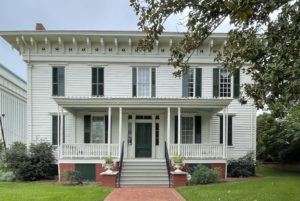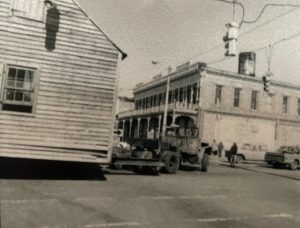In which Doris is reminded about the original definition of moving house.
 Sid wrote about our entirely delightful visit to Heritage Hall in Madison, hosted by the hugely knowledgeable and charming Sara Lynn Holbert. But I see that he failed to mention that the house was moved in 1908. Now Heritage House is not small and does not appear to be particularly portable, but when the original owners sold half the plot to make room for a church, they shifted the house over a bit and also rotated it through 90′ so it now faces onto a better street. When we asked how the move was done, Sara Lynn said “Well I guess it just took a lotta horses and a lotta logs and a lotta time”. Which is probably a lotta understatement.
Sid wrote about our entirely delightful visit to Heritage Hall in Madison, hosted by the hugely knowledgeable and charming Sara Lynn Holbert. But I see that he failed to mention that the house was moved in 1908. Now Heritage House is not small and does not appear to be particularly portable, but when the original owners sold half the plot to make room for a church, they shifted the house over a bit and also rotated it through 90′ so it now faces onto a better street. When we asked how the move was done, Sara Lynn said “Well I guess it just took a lotta horses and a lotta logs and a lotta time”. Which is probably a lotta understatement.
There are of course many different ways to move house, and one other way is demonstrated by the First (and last) White House of the Confederacy in Montgomery. This used the Tear It Down, Number All The Bricks and Build It Again method, and unsurprisingly required the efforts of rather more people to do it. A wall of photos documents the redoubtable ladies of the First White House Association who achieved this in 1921.
Eschewing the Interstates means that we are driving through a lot of back-country America, where every town worth its salt has a U-Haul depot, a large facility for storing your less-wanted possessions, and a Portable Buildings Shop. Once you have got your eye attuned to a Portable Building you can see how many houses were built, or at least started, this way. 
 And of course, if you don’t like your neighbours, there is always a simple solution available. This post makes entertaining reading on different ways to move a historic house, including case studies and videos.
And of course, if you don’t like your neighbours, there is always a simple solution available. This post makes entertaining reading on different ways to move a historic house, including case studies and videos.
Don’t be put off by the fact that it starts by giving the invaluable advice “You need to have disconnected water, telephone, and electric lines ahead of the move.”



